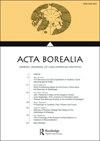Postcolonial polar cities? New indigenous and cosmopolitan urbanness in the Arctic
IF 0.6
4区 社会学
0 HUMANITIES, MULTIDISCIPLINARY
引用次数: 7
Abstract
ABSTRACT The arrival into geography, and especially urban geography, of a frame of questioning coming from postcolonial studies has contributed to a fascinating debate about what a “postcolonial” city is and how the urban duality between ethnically, socially, and spatially segregated “European” towns and “native” settlements is being reformulated and transformed. Obviously, Arctic cities are not postcolonial in the political sense of being independent from the former colonial centre – although this process may be under way in Greenland – but they have seen a progressive move from a Eurocentric culture toward greater hybridization. This article looks into two new trends that contribute to making Arctic cities postcolonial: first, the arrival of indigenous peoples in cities and the concomitant diminution of the division between Europeans/urbanites and natives/rurals; and second, the arrival of labour migrants from abroad, which has given birth to a more plural and cosmopolitan citizenry. It advances the idea that Arctic cities are now in a position to play a “decolonizing” role, in the sense of progressively erasing the purely European aspect of the city and making it both more local and rooted (through indigenous communities) and more global and multicultural (through foreign labour migrants).后殖民极地城市?北极新的本土和国际化都市
摘要后殖民研究提出的一系列问题进入了地理学,尤其是城市地理学,这引发了一场关于什么是“后殖民”城市以及种族、社会和空间隔离的“欧洲”城镇和“本土”定居点之间的城市二元性是如何被重新制定和转变的有趣辩论。显然,北极城市并不是从前殖民中心独立出来的政治意义上的后殖民城市——尽管这一过程可能正在格陵兰岛进行——但它们已经看到了从欧洲中心文化向更大程度混合的进步。这篇文章探讨了促使北极城市后殖民的两个新趋势:首先,土著人民来到城市,随之而来的是欧洲人/城市居民和本地人/农村人之间的分裂缩小;其次,来自国外的劳工移民的到来,催生了一个更加多元化和国际化的公民群体。它提出了这样一种观点,即北极城市现在可以发挥“非殖民化”作用,即逐步消除城市的纯欧洲方面,使其更具地方性和扎根性(通过土著社区),并使其更全球化和多元文化(通过外国劳工移民)。
本文章由计算机程序翻译,如有差异,请以英文原文为准。
求助全文
约1分钟内获得全文
求助全文

 求助内容:
求助内容: 应助结果提醒方式:
应助结果提醒方式:


